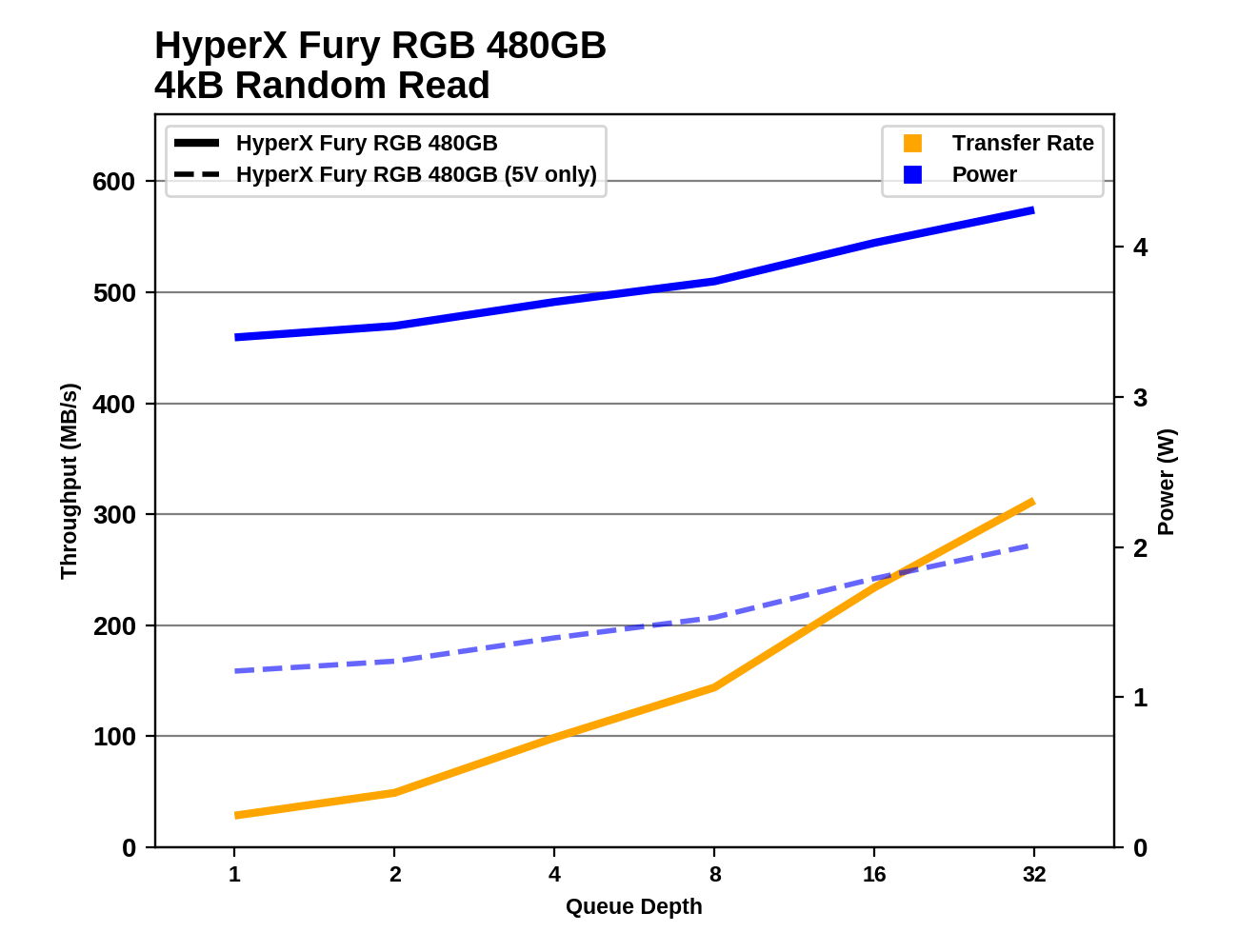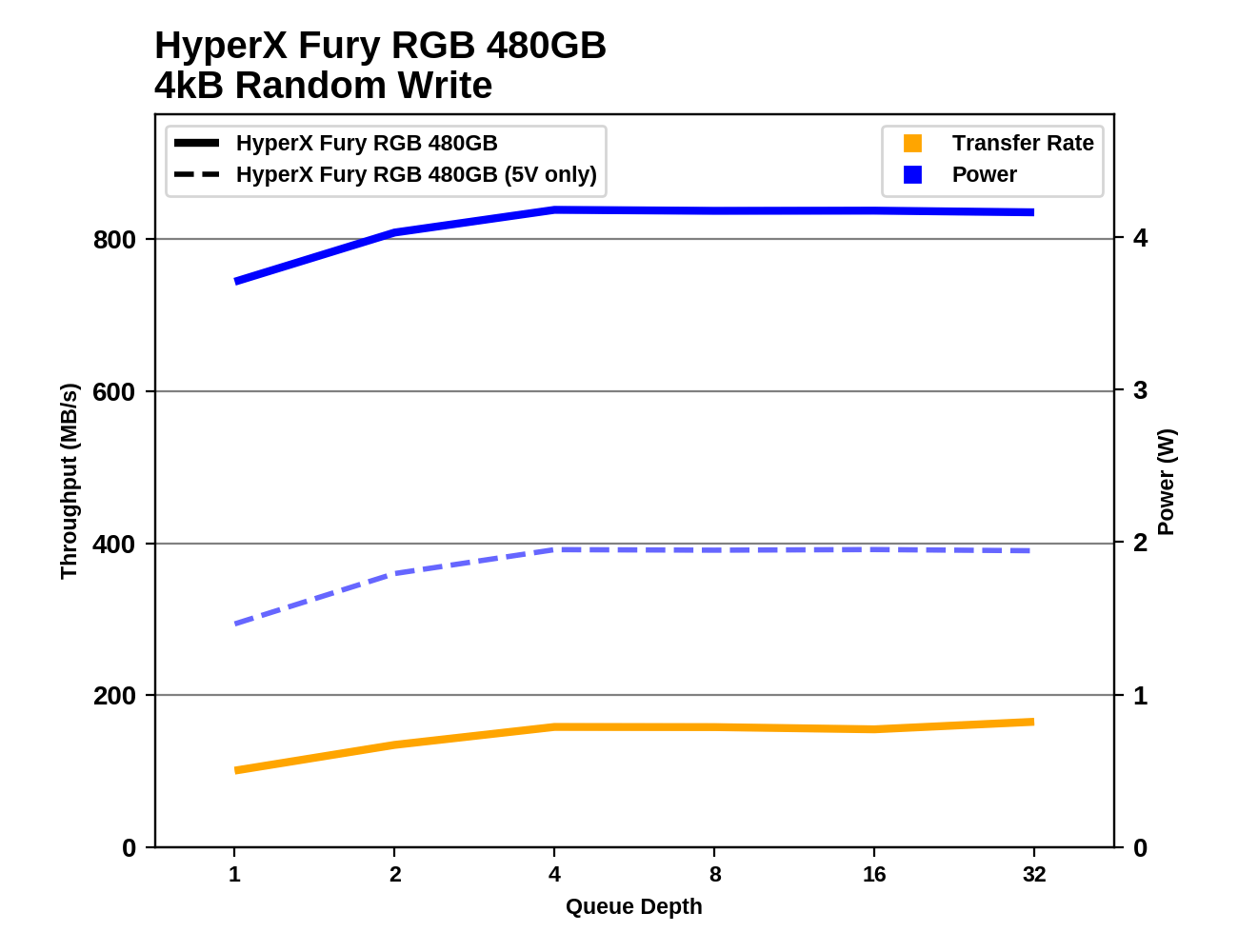The Kingston HyperX Fury RGB SSD Review: Bright Idea, Dimmed Performance
by Billy Tallis on September 24, 2018 8:35 AM ESTRandom Read Performance
Our first test of random read performance uses very short bursts of operations issued one at a time with no queuing. The drives are given enough idle time between bursts to yield an overall duty cycle of 20%, so thermal throttling is impossible. Each burst consists of a total of 32MB of 4kB random reads, from a 16GB span of the disk. The total data read is 1GB.

The QD1 burst random read performance of the HyperX Fury RGB is about 18% slower than what the Plextor M8V manages with the same NAND flash, and 40% slower than the Crucial MX500.
Our sustained random read performance is similar to the random read test from our 2015 test suite: queue depths from 1 to 32 are tested, and the average performance and power efficiency across QD1, QD2 and QD4 are reported as the primary scores. Each queue depth is tested for one minute or 32GB of data transferred, whichever is shorter. After each queue depth is tested, the drive is given up to one minute to cool off so that the higher queue depths are unlikely to be affected by accumulated heat build-up. The individual read operations are again 4kB, and cover a 64GB span of the drive.

On the longer random read test with some higher queue depths involved, the Fury RGB manages to be clearly faster than the DRAMless SATA drives and is only a little bit slower than average for mainstream SATA drives.
 |
|||||||||
| Power Efficiency in MB/s/W | Average Power in W | ||||||||
When excluding the LEDs power draw, the Fury RGB has reasonable power efficiency during low queue depth random reads since the power draw and performance are both just a bit below average.
 |
|||||||||
The random read performance of the Fury RGB scales up with increasing queue depth better than the DRAMless drives, but most of the other mainstream drives show at least slightly better scaling.
Random Write Performance
Our test of random write burst performance is structured similarly to the random read burst test, but each burst is only 4MB and the total test length is 128MB. The 4kB random write operations are distributed over a 16GB span of the drive, and the operations are issued one at a time with no queuing.

The QD1 burst random write performance of the HyperX Fury RGB is slightly better than the DRAMless SATA SSDs but is almost 30% slower than a good mainstream SATA drive.
As with the sustained random read test, our sustained 4kB random write test runs for up to one minute or 32GB per queue depth, covering a 64GB span of the drive and giving the drive up to 1 minute of idle time between queue depths to allow for write caches to be flushed and for the drive to cool down.

The decent burst random write performance from the Fury RGB doesn't hold up during the longer sustained random write test. The Fury RGB outperforms the DRAMless SATA drives but it is closer to their level of performance than to the typical mainstream SATA SSDs.
 |
|||||||||
| Power Efficiency in MB/s/W | Average Power in W | ||||||||
With average power consumption but sub-par performance, the Fury RGB's power efficiency rating is very low even before the LED's power draw is included.
 |
|||||||||
The random write performance of the HyperX Fury RGB does scale up slightly with increasing queue depths, but it plateaus at a performance level that is only slightly faster than the Toshiba TR200 DRAMless SATA SSD.










45 Comments
View All Comments
Dragonstongue - Monday, September 24, 2018 - link
what a stupid mofo drive design...have to use a 4 pin 12v power instead of just allowing the drive to use the power that it is given etc etc..Bravo Kingston, you get a reward for one of the dumbest moves to join the RGB disco light show craze and fail miserably at it.
olafgarten - Monday, September 24, 2018 - link
It's so stupid when they put LEDs on everything.My Strix GTX980 has a white Led that can't be disabled and stays on even when the computer is shut down, I had to cover it up with tape as it was disturbing my sleep!
PeachNCream - Tuesday, September 25, 2018 - link
Strix-branded products are stupid anyway. They are part of that immature gamer-in-the-basement segment of the PC market. That doesn't justify the stupid LEDs, of course. Does your PSU have a physical switch it? You could use that or turn off power at the surge suppressor to shut the LED lights off without bothering with tape. Flipping the physical switch is a good idea anyway to reduce vampire draw from active devices to marginally reduce your electrical power bill while also cutting back on the risk of losing hardware to spikes caused by thunderstorms.MadAd - Monday, September 24, 2018 - link
woohoo, all i need now is some LED cables, an LED optical drive and some LED thermal paste and im all set!!MrSpadge - Monday, September 24, 2018 - link
> LED optical driveNope, you really want that light source to be a laser!
mobutu - Monday, September 24, 2018 - link
yuckranran - Monday, September 24, 2018 - link
So, this is like those people that buy the little Civic's or Corolla's and then pump tons of money into crazy wheels, air foils, noisy exhaust, and speaker systems that together probably cost more than the car is worth........... totally useless...Lolimaster - Monday, September 24, 2018 - link
Over 22cents per GB when better SSD's from Crucial and Samsung are jumping around 16cents per GB :Dzodiacfml - Monday, September 24, 2018 - link
Thanks for the useful title, I don't have to read the review. I clicked on your ads thoughqlum - Tuesday, September 25, 2018 - link
I feel for the poor guy who is inevitably going to put this in his laptop.